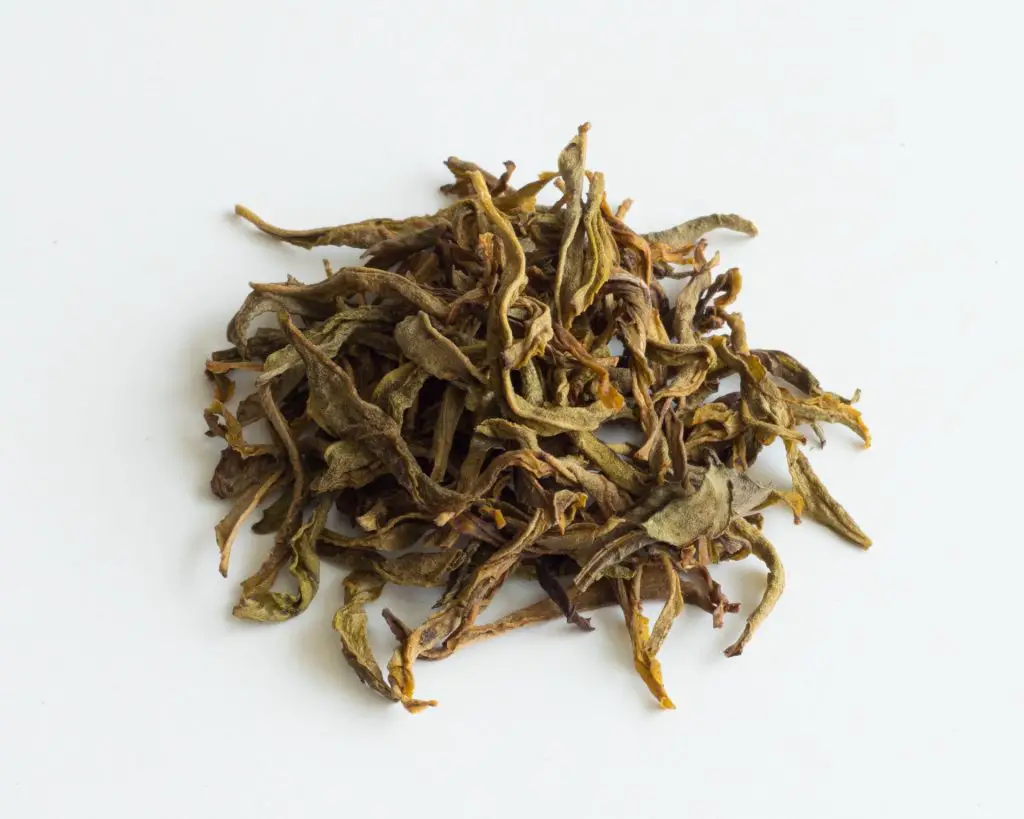Dating back as early as 2737 BC, tea has an intricate history in its place of origin, China. Derived from steeping Camellia sinensis leaves and buds in hot water, tea is categorized based on how it’s processed and prepared after harvest. These categories include green tea, black tea, and oolong tea, among a few others.
Unlike green tea which is left unoxidized or black tea that is fully oxidized, oolong tea leaves are partially oxidized during processing. Bai Jiguan tea, a type of oolong, is distinct from the others in this category. Grown in the province of Fujian, it offers tea drinkers a unique flavor due to its specific oxidation percentage.
Oolong Tea Specifics
One thing that makes this beverage different from other teas is the unique oxidation process that is custom to each of the oolong varieties. Typically, the amount of oxidation the leaves undergo can range anywhere from only 8% to a whopping 85%. With such a vast range of how oxidized oolong tea leaves can be, there are various aromas, flavors, and appearances for tea lovers.
Some of the most famous oolong teas are harvested and processed in the Wuyi Mountains. Si Da Ming Cong, a collection of four varieties of oolong teas produced in this remote Chinese location, is among some of the most popular today.
The four types of oolong tea that grow on these famous tea bushes, and are nestled under the category known as Si Da Ming Cong, include:
- Da Hong Pao
- Shui Jin Gui
- Tie Luo Han
- Bai Ji Guan
The History of Bai Jiguan Tea
When compared to other oolong teas produced in the same region, Bai Ji Guan is more of a delicacy and harder to get. Mentioned in written historical records dating back to the Ming dynasty (1368-1644), this rare tea is allowed to oxidize somewhere between 60% and 80%.
Legend Has It
The legend of Bai Jiguan tea, whose name translated means ‘white rooster’, is said to have gotten its name from the actions of a brave rooster who saved an innocent baby from an eagle. Sacrificing himself to protect the tiny human, the rooster was buried by a monk who witnessed the noble animal’s bravery.
It is said that on the spot where the rooster was laid to rest the first tea bush grew. To honor the brave rooster, the tea produced from the bush was named after it.
Harvest & Production
The leaves processed to make Bai Jiguan tea, also commonly referred to as Bai Ji Guan tea, are distinct and easy to recognize due to their bright yellow appearance. One bud and two leaves are plucked from the plant during the spring harvest. The leaves measure anywhere from 8.6 to 9.5 cm long and 3.3 to 3.8 cm wide.
Once the young yellowish leaves have been collected by hand, they are shaken and rolled. This helps bring out the unique flavor. The last step of processing includes roasting the leaves for 8 to 12 hours (at least once and up to three times) to ensure they are fully processed and ready for packaging.
Gong Fu Brewing Method
Traditionally, Chinese tea was brewed with a higher ratio of tea leaves to water than more modern methods. It also involves a shorter steeping time when compared to modern brewing instructions.
To brew a traditional cup of Bai Jiguan tea, you will need:
- Yixing teapot- a purple clay pot used for steeping tea leaves
- Vessel- for serving the tea
- Cups- to enjoy the tea out of
Five Steps
In just several steps, and with the items outlined above, you can enjoy a freshly brewed cup of Bai Jiguan tea. It should be noted that traditional brewing experiences were meant to be fully enjoyed, not rushed. The tea, and the whole process, is meant to be smelled, savored, appreciated, and perfected. Depending on which company you purchase the tea from, the directions may also vary slightly.
- Bring some water (preferably fresh or spring water) to a boil.
- While waiting for the water to come up to temperature, preheat the clay teapot, serving vessel, and tea cups with hot water. Then, discard the used water.
- Place 8 g of tea leaves into the teapot for every 100 ml of boiling water that will be used. When the water starts to boil, fill the teapot with the boiling water. (Remember to keep with the correct ratio for the amount of leaves that are in the pot.)
- Allow the leaves to steep for 5 seconds and then pour the tea directly into the serving vessel.
- Strain the tea as you pour it into the cups and then enjoy. (Be sure not to get rid of the leaves, as they can be used a few more times.)
Appearance, Aroma, & Taste
While the leaves are a darker yellowish-green color, the brewed tea takes on a yellow-orange tinge. A freshly brewed cup of Bai Jiguan tea is said to have a floral smell that is slightly enhanced by toasty notes of honey. It delivers a sweet and slightly fruity taste.
Caffeine & Nutrition
Per 8 f oz serving, typical oolong tea has anywhere from 37 to 55 mg of caffeine. The caffeine content is hard to pinpoint due to differences in the brewing method and infusion time, as well as the harvesting and processing methods of the tea leaves. As with most other teas, this oolong variety is low in nutritional value with zero calories, fats, carbs, and proteins.
Bai Jiguan Tea
Unlike other basic types of tea, oolong tea leaves are partially oxidized. Bai Jiguan tea, which is harvested in the spring, is an example of this type of tea. Its distinguishable leaf color, floral aroma, and sweet taste are decadent and highly prized. Being produced in smaller batches compared to other types of tea, ‘white rooster’ it is considered to be rare. Tied deeply into Chinese culture, Bai Jiguan is a tea lover’s dream and should be experienced by those for an appreciation for oolong tea at least once.
Attribution
Feature Image: Difference engine, CC BY-SA 4.0 https://creativecommons.org/licenses/by-sa/4.0, via Wikimedia Commons

